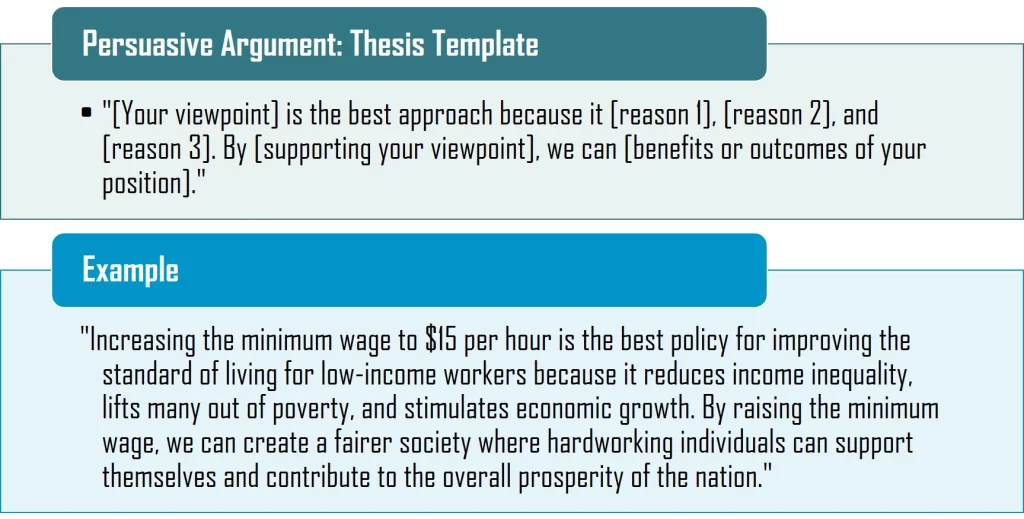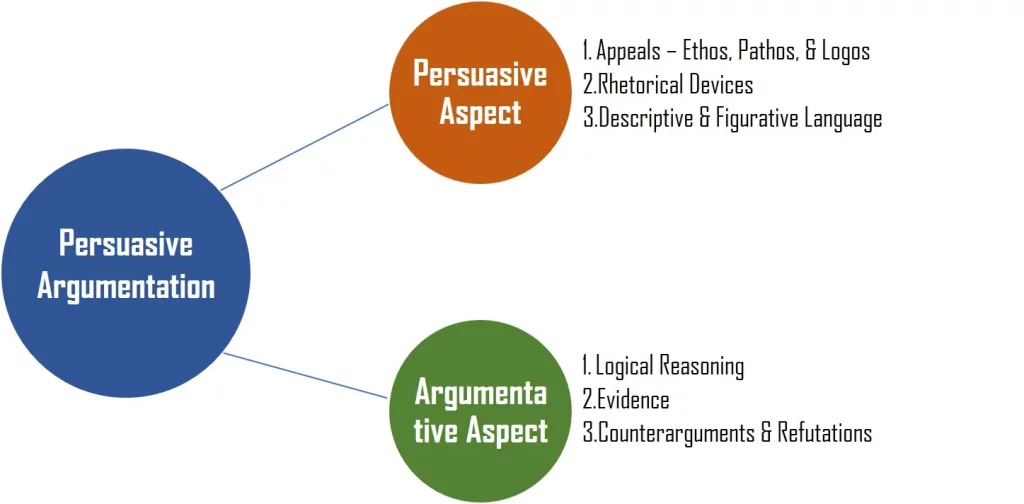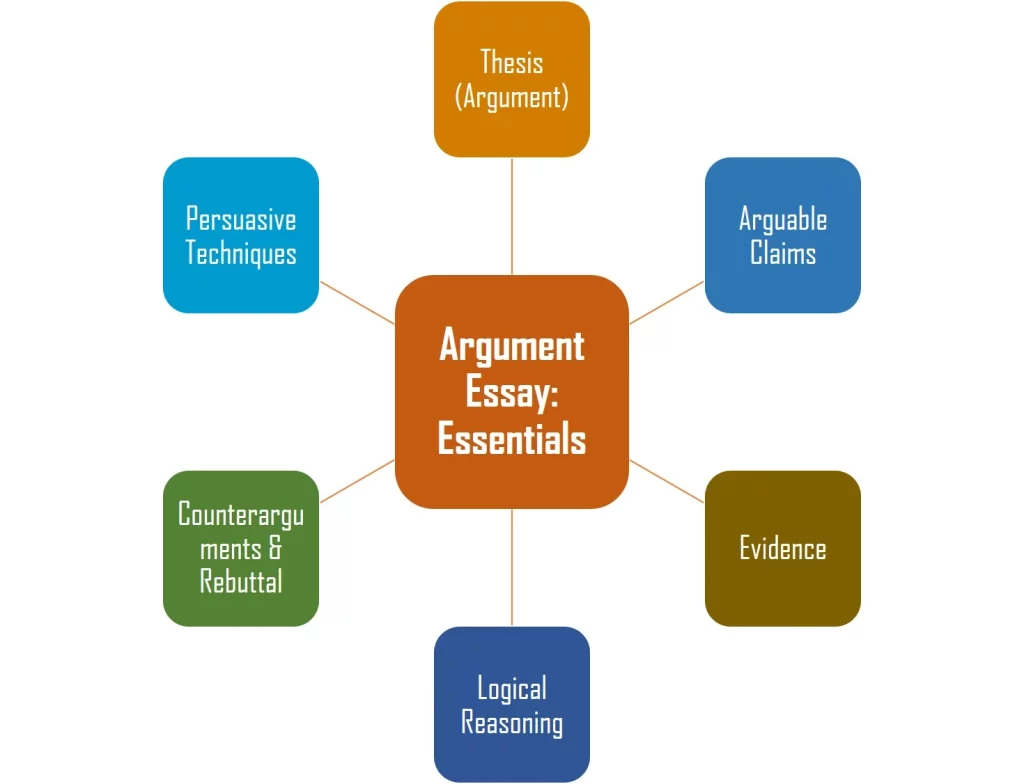- 5-Paragraph Argumentative Essay on Euthanasia
- Aristotelian Argument Essay on Marijuana
- Toulmin Argument Essay on Artificial Intelligence
- Rogerian Argument Essay on Gun Control
- Rebuttal Argument Essay on Renewable Energy
- Sample Historical Argument Essay on the Industrial Revolution
- Literary Argument Essay on 'The Cask of Amontillado'
- Persuasive Argument Essay: Financial Literacy
- Persuasive Argument Essay: Social Media and Politics
- Proposal Argument Essay on Reusable Containers
- Proposal Argument Essay on Workplace Wellness
- Rhetorical Evaluation Argument Essay: MLK's "I Have a Dream"
- Literary Evaluative Argument Essay: "To Kill a Mockingbird"
- Narrative Argument Essay on Resilience
- Definition Argument Essay on Privacy
- Causal Argument Essay on Education

Persuasive argumentation refers to the use of logical reasoning, evidence, and rhetorical techniques to convince an audience to adopt or support a particular viewpoint or take a specific action. The goal of persuasive argumentation is to sway the audience’s opinions, beliefs, or behaviors by presenting compelling arguments and appealing to their emotions, values, and sense of logic.
Here are sample persuasive argument essays for college students:
Persuasive Argument Essay on Social Media & Politics
Persuasive Argument Essay on Financial Literacy
Persuasive Argumentation – A Blend of Two Rhetorical Styles

Persuasive arguments can be seen as a blend of two rhetorical styles: persuasive writing and argumentative writing. Let’s explore these two styles:
-
Persuasive Writing:
Persuasive writing aims to convince the reader to adopt a particular opinion, take a specific action, or change their beliefs or behaviors. It focuses on appealing to the reader’s emotions, values, and desires. Key features of persuasive writing include:
-
Argumentative Writing:
Argumentative writing focuses on presenting logical arguments and supporting evidence to present a position on a specific viewpoint. It relies on logical reasoning and critical thinking. Key features of argumentative writing include:
In persuasive arguments, these two rhetorical styles blend together to create a compelling and persuasive piece of writing. Persuasive writing brings in emotional appeals, rhetorical devices, and audience consideration to engage and persuade the reader. Argumentative writing provides the logical framework, evidence, reasoning, and structure to support the claims and make a convincing case. By combining persuasive writing techniques with the logical rigor of argumentative writing, persuasive arguments are more effective in swaying the reader’s opinion and motivating them to take action or embrace a particular viewpoint.
How to Construct Strong and Coherent Persuasive Arguments
- Understand the purpose and context: Clarify the specific purpose of your persuasive argument essay and the context in which it will be presented. Consider the topic, audience, and your desired persuasive outcome.
- Identify your main argument or position:
- Craft your thesis statement:
- Generate supportive claims:
- Incorporate Evidence, Examples and Reasoning:
- Ensure coherence and logical flow: Review your thesis statement and supportive claims to ensure that they are logically connected and support your overall argument. They should build upon one another and contribute to the persuasive impact of your essay.
Remember, a strong thesis statement and supportive claims in a persuasive argument essay should clearly articulate your position, provide a roadmap for your essay, and offer compelling evidence and reasoning to support your argument.
Developing an Effective Thesis Statement
Here’s a template for a persuasive argument thesis statement:
“[Your viewpoint] is the best approach because it [reason 1], [reason 2], and [reason 3]. By [supporting your viewpoint], we can [benefits or outcomes of your position].”
Let’s break down this template:
- State your viewpoint: Clearly express the position or viewpoint you are advocating for in your persuasive argument.
- Provide your reasons: List the primary reasons or arguments that support your viewpoint. You can have more than three reasons, but this template provides space for three.
- Explain the benefits or outcomes: Describe the positive results or benefits that will occur if your viewpoint is adopted.
Here’s an example using the template:
“Switching to renewable energy sources is the best approach to combat climate change because it reduces greenhouse gas emissions, decreases our reliance on finite fossil fuels, and creates a cleaner and more sustainable environment. By transitioning to renewable energy, we can slow the progression of global warming, preserve natural resources, and ensure a healthier planet for future generations.”
In this thesis statement, the viewpoint is clear (switching to renewable energy), and it provides three reasons (reducing greenhouse gas emissions, decreasing reliance on fossil fuels, and creating a cleaner environment) as well as the expected benefits (slowing global warming, preserving resources, and ensuring a healthier planet). It sets the stage for an essay that will provide evidence and reasoning to support this persuasive argument.
Persuasive Arguments Examples

Below are 10 examples of persuasive arguments, along with ideas on how to expand each component. Remember, persuasive arguments should be supported by evidence, logical reasoning, and appeals to the audience’s emotions and values to effectively convince and influence their perspective.
- Persuasive Argument Example on Renewable Energy:
- Central Claim: The government should invest in renewable energy sources.
- Supportive Claims:
- Counterargument and Rebuttal:
- Persuasive Argument Example on Education:
- Central Claim: Physical education should be a mandatory subject in schools.
- Supportive Claims:
- Counterargument and Rebuttal:
- Persuasive Argument Example on Animal Testing:
- Central Claim: Animal testing for cosmetics should be banned.
- Supportive Claims:
- Counterargument and Rebuttal:
- Persuasive Argument Example on Legal Drinking Age:
- Central Claim: The legal drinking age should be lowered to 18.
- Supportive Claims:
- Counterargument and Rebuttal:
- Persuasive Argument Example on Healthcare:
- Central Claim: Access to affordable healthcare should be a basic human right.
- Supportive Claims:
- Counterargument and Rebuttal:
- Persuasive Argument Example on Environmental Pollution:
- Central Claim: The use of plastic bags should be banned.
- Supportive Claims:
- Counterargument and Rebuttal:
- Persuasive Argument Example on the Death Penalty:
- Central Claim: The death penalty should be abolished.
- Supportive Claims:
- Counterargument and Rebuttal:
- Persuasive Argument Example on Learning:
- Central Claim: High school students should be required to learn a second language.
- Supportive Claims:
- Counterargument and Rebuttal:
- Persuasive Argument Example on Smoking:
- Central Claim: Smoking should be banned in all public spaces.
- Supportive Claims:
- Counterargument and Rebuttal:
- Persuasive Argument Example on School Uniforms:
- Central Claim: School uniforms should be mandatory in all schools.
- Supportive Claims:
- Counterargument and Rebuttal:
Remember, the key to writing a successful persuasive argument is to present a clear and compelling thesis or claim, support it with strong evidence, anticipate and address counterarguments, and use persuasive language and reasoning to convince your audience of the validity of your position.
